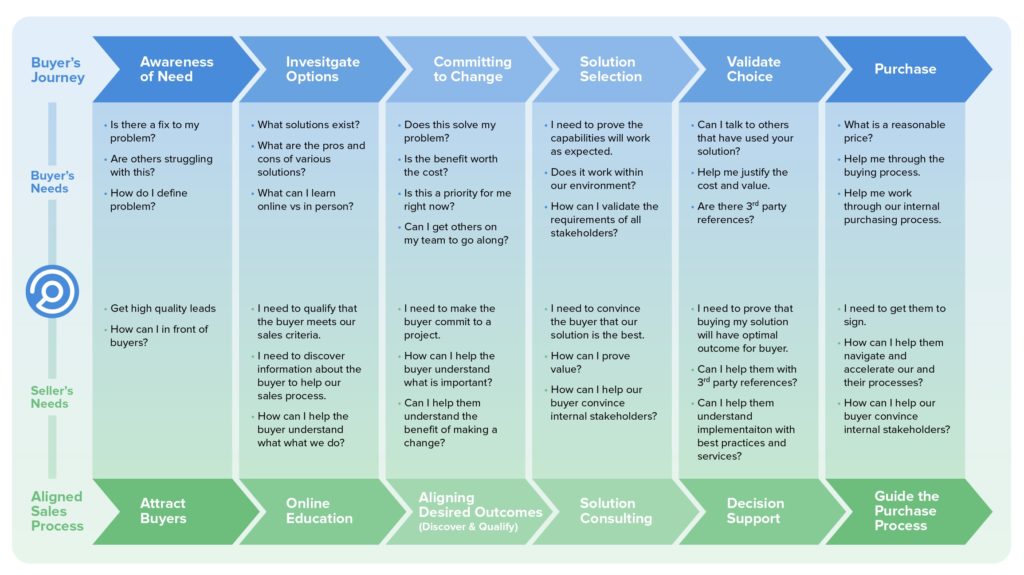Road trips are a great way to get to know someone. They reveal compatibilities, interests, and perspectives on everything from the best route to worthwhile stops. These rites of passage are similar to shared expeditions of buyers and sellers. Both require clear understanding of the ultimate destination, open communication, and eagerness to engage.
Still, buyers and sellers are different. On one side, there are needs to fulfill and benefits to derive; on the other, revenue goals and customer satisfaction. What is a journey for buyers is a process for sellers. Successful sales and marketing teams manage both paths to mutual advantage while accelerating the results they care about most.
From Then to Now
We hear many stories about how the buyer’s journey is changing — how it’s becoming more fluid and dynamic, and how buyers have more control than ever before. All true. What’s not true, but remains broadly perceived, is that the journey is now a random walk, and that buyers are less likely to follow a well-worn trail and more apt to advance from one stage to another with little predictability. High-performing sellers know better. Today, we’ll share how they remain proactive — and how sales enablement helps establish strong links between the sales process and the buyer’s journey.
Before describing how to make journey-process alignment possible in your organization, let’s quickly reset.
Like the basic stages of the buyer’s journey, marketing fundamentals remain unaltered. Decision-making processes, in particular for complex purchases, conform to the same pattern they’ve followed for decades.
Whether you’re buying a new car, a ski jacket that’s a little outside your price range, or enterprise software, the journey is consistent.
While some stages may occasionally be skimmed (perhaps you’re aware of the existence of ski jackets) and circularity is possible (for example, upon reaching the negotiation phase you discover a new solution and decide to restart your process), the buyer’s journey of the future will remain clearly recognizable. What will change is how sales teams evolve to make the most of it.
When the classic sales process is set against the buyer’s journey, it’s easy to spot the alignment shortages many of today’s sales teams are facing.

The key question for sales and marketing teams is therefore: How do I adapt my sales process to the buyer’s journey?
For sales managers seeking to increase rep effectiveness and drive consistency in how they leverage sales content for maximum gain, sales process revisions offer huge upside. The biggest reason is that they demand businesses more deeply consider the needs of their target audience. Rather than centering their sales process on a scripted sequence of product- or service-first messages, aligned businesses focus first on guiding buyers through their journey. They map their process to buyers’ needs while preserving the flexibility to challenge, support, and consult buyers at every stage. By investing the upfront time necessary to executing on this strategy, aligned businesses position themselves for vastly improved sales effectiveness.
Illustrated below is an example of an aligned sales process set against the buyer’s journey. As you can see, it’s a process that’s more dynamic, flexible, and customer-centric.

Five Steps to Better Connecting Your Sales Process to the Buyer’s Journey
Step 1: Reframe stage definitions and goals
Draw a table with your buyer’s journey across the top, then skip down three rows and add your sales process. In the second row, note what the buyer is trying to accomplish in each sales stage. In the third row, jot what you are trying to accomplish in each sales stage. Now you have a high-level map of your sales process and your audience’s journey. Do they align? If so — great; if not, read on.
For many sales teams, reframing stage definitions and goals can quickly remedy misalignment. As an example, it’s common for a sales process to include a “qualify” stage where sellers assess whether or not buyers are likely to purchase within a reasonable timeframe. In this case, “qualify” represents a sales perspective. Meanwhile, the parallel objective from the buyer’s point of view is “committing to change.”
Reframing stages and goals helps sellers reconcile buyer preferences with their own intuition and leads to more impactful conversations. With this in mind, we recommend keeping the following questions in your back pocket:
- Can your buyers articulate the need they are trying to solve?
- Can you help buyers refine the scope of their problem?
- Is your buyer’s problem something that your company can help solve and is solving that problem part of your sales process?
- Is your buyer committed to making a change? Can you help evaluate the pros and cons of making that change?
- Can you help buyers identify, include, and convince others in your target company that they share this need?
Answers to these questions will help you better establish the content and engagement strategy critical to delivering what your buyers demand. Our recommendation: look for a sales enablement platform that accommodates not only the content capabilities you expect, but also the customer engagement and analytics that will support your sales process from start to finish.
Step 2: Identify Value Points
Once your process steps are aligned, pinpoint how you can provide value to buyers in each stage. Think beyond product capabilities, and instead focus on solution evaluation and ensuring multiple perspectives within your buyer’s organization are addressed. The key is to pivot the question from, “What do I need to get from the buyer?” to “How can I help the buyer get what they need?” Better sales performance begins with this simple shift.
Step 3: Identify Tools, Content & Resources
Help buyers marshal the resources required to deliver on their goals. One way is to explore the following categories and become a go-to resource for buyers.
- Product and solution education: What product specs, solution guides, industry specific collateral or industry expert advice do your buyers need? Where in the buyer’s journey will this be most helpful?
- Committing to change: What analyst reports, case studies, or ROI calculators will showcase the need for a change of direction?
- Solution selection: How can you use evaluation checklists, comparison charts, 3rd-party advice, and product trials to help buyers choose among multiple products? Does your sales process meet this need at the most opportune stage of the buyer’s journey?
- Selection validation: Mitigate your buyers’ concerns by referencing proof-of-value trials, customer references, and industry experts.
Once you’re clear on the above, make certain your reps are able to find, share, customize, and analyze the content that satisfies these important buyer needs.
Step 4: Test and Validate
Changes to sales processes can be sensitive and justify the adage “measure twice, cut once.” We recommend identifying a few high-performing sales reps who are consultative, customer-first thinkers already. The biggest reason is that they’ll likely have immediate, market-validated feedback and recommendations on whether or not revisions to your sales process will correspond with the buyer’s journey. (Note: Many of these reps are also likely to be active participants in your sales enablement strategy.)
You should also test the effectiveness of your new process by running a pilot program. Train a subset of your sales team on the advantages of linking your sales process to the buyer’s journey, and how to translate guidance into action steps. If your sales cycle is long or complex, it may be difficult to confirm the benefits of your new process with a statistically relevant sample. However, salespeople will quickly acquire a gut feeling on whether or not it’s working and — until additional data can be gathered — should be trusted for near-term insights.
Step 5: Codify, Train, and Commit
Moving a sales organization to a new way of thinking is hard. By investing in training, you’ll help reps more deeply understand your new process and the reason it will make a positive difference for them.
In addition (and if you haven’t already), be sure to digitize your playbook. By delivering your playbook in accessible, easy-to-consume, modularized chapters, you’ll give reps the head start they need. This is one of the best ways we’ve seen to codify a sales process and move organizations forward fast.
Go Forth
Modern sales enablement platforms help reps connect their sales process to the buyer’s journey. When this happens, reps maintain control of the customer dialogue. They use the power of sales content and training to ensure the right message is delivered at the right time to the right audience. In short, they avert chaos by leveraging technology and insights to steer engagement in a productive direction.
The better you’re able to align perspectives on the buyer’s journey and sales process and use them to fine-tune your sales content strategy, the more effective your reps will be. Luckily, the art and science required to get there is more straightforward than many teams realize. And with the right sales enablement platform, the benefits are more accessible than ever.


